|
Symbols
were used by primitive man as the earliest form of writing. With many symbolic
illustrations great care has been taken to embellish, decorate, and adorn the
symbol; sometimes to clarify the symbolic meaning, and in others to disguise or
obfuscate the symbolic content. This
paper explores two classic examples of symbolic illustrations which appear in
Book Two, Chapter xxvii of Three Books of Occult Philosophy[i],[ii]
by the noted 16th Century Alchemist, Henry Cornelius Agrippa,
entitled “Of the Proportion, Measure, and Harmony of Man’s Body”. These
symbols are very complex geometric figures accompanied by obscure references to
philosophical concepts. The exploration undertaken in this paper will
specifically focus upon the geometric properties of the figures.
Agrippa’s
Figures
The
unique proportional relationships displayed by the human body appear to have
been known in times of antiquity. Vitruvius (circa 30 B.C.) in Book III of his
treatise De Architectura[iii]
detailed these proportions in writing as follows:
“The
navel is naturally placed in the centre of the human body, and, if in a man
lying with his face upward, and his hands and feet extended, from his navel as
the centre, a circle be described, it will touch his fingers and toes. It is not
alone by a circle, that the human body is thus circumscribed, as may be seen by
placing it within a square. For measuring from the feet to the crown of the
head, and then across the arms fully extended, we find the latter measure equal
to the former; so that lines at right angles to each other, enclosing the
figure, will form a square”.
This
description (circa 1487) was used by Leonardo DaVinci to create the famous
drawing entitled Vitruvian Man (Figure 1)[iv].
Figures similar to Leonardo’s have been created over a very broad span of time
(some earlier, some later) by Philosophers and Artists such as Hildegard von
Bingen (1098-1179), Fra Giovanni Giocondo (1435-1515), Bartolommeo Caporali
(1442-1509), Cessare Cesariano (1483-1543), Francesco di Georgio (1482-1489),
Robert Fludd (1617), and Eliphas Levi (1810-1875).
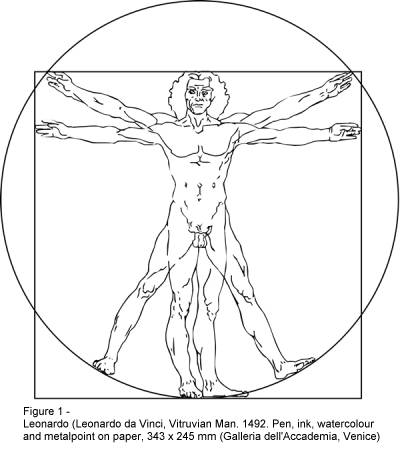
Agrippa
was likely aware of many of these drawings when in 1651 he published his Three
Books of Occult Philosophy. The six figures published by Agrippa in Book
Two, Chapter xxvii are, at first glance, quite similar to Vitruvian Man
(Figure 2 is a collage of these figures[v]).
In these figures, Agrippa symbolically suggests, by enclosing man in a circle
(itself the symbol of perfection and infinity) his (man’s) relationship to the
divine or cosmic realm. Another of these figures illustrates the human form with
outstretched arms (similar to Vitruvian Man) enclosed in a square, illustrating
the "four square measure," where man "will make a quadrature
equilateral"[vi].
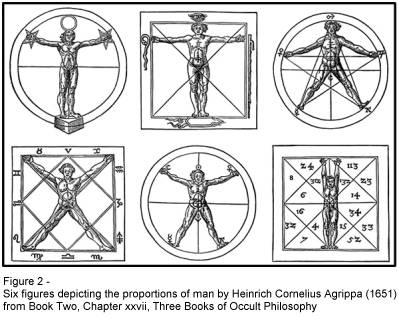
I
have selected two of these six figures for analysis, and they are reproduced
below as Figure 3 and Figure 4. Please
note that while the remainder of Agrippa’s figures in Chapter xxvii are also
immensely interesting, these two share a common symbolic theme and have
identical geometric properties. Limitations of space do not permit the other
figures to be fully discussed or further developed, although they will be
briefly considered in relation to the two figures of interest.
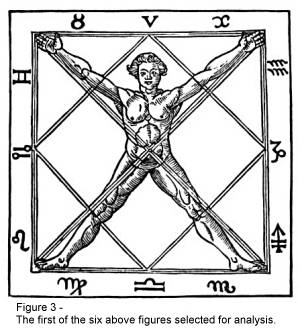
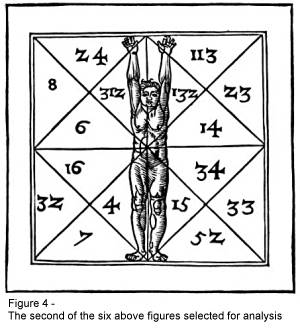
Geometric
Properties
The
geometric concepts represented by both Figure 3 and Figure 4 are essentially
identical. In fact the analysis of these figures is best handled by treating
them as a single composite figure, combining certain elements of each. Two
unique characteristics of the figures are especially worth noting; First of all,
the body position of the human form in Figure 3 is such that the arms and legs
are aligned with the diagonal of the Square in which it appears. The body
position of the form in Figure 4 on the other hand is aligned with the height
dimension of the square. It is an important point to recognize that if the human
form in Figure 3 is rotated about its center point (the navel) the hands and
feet will trace a circle which neatly circumscribes the square. Also, in regard
to the symbols of the zodiac as they appear in Figure 3, the reader will note
that the zodiac typically is displayed in a circular format, corresponding to
the celestial sphere. The fact that the symbols of the zodiac appear in the
border as they do in this figure, fairly begs the viewer to visualize a circle
inscribed within the outer square. Please also note that the symbols of the
zodiac are also critical to an understanding of the figure’s philosophical
interpretation.
In
Figure 4, the hands and feet of the human form, when rotated in a similar
fashion, will trace a circle which is exactly inscribed within the square.
Figure 4 requires that for geometric analysis we temporarily ignore the
numerical values which appear in each of the triangular sections of the drawing.
Note that absent the human form, Figure 4 resembles Figure 3 except that two
additional lines have been added perpendicular to one another and intersecting
at the center.
Figure
5 is a composite of Figure 3 and Figure 4, absent the human form, zodiac, and
numbers and with the geometric shapes labeled to facilitate discussion. Figure 5
does however add two concentric circles to the composite. One of the two squares
(ABDC) therefore appears circumscribed about the larger circle, and the other (EFGH)
appears inscribed within the smaller circle. These squares are arranged such
that the diagonals of square EFGH (Line FH and Line EG) are both the diameters
of the circle, as well as the height and width, respectively, of square ABDC.
The multiple intersections of the diagonals of the squares and of the
diagonals with the sides of the squares produce no fewer than sixteen (16)
identical isosceles right triangles.
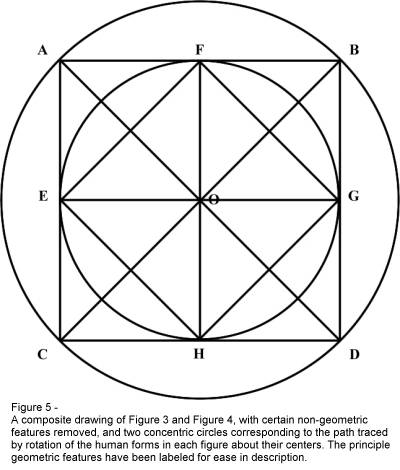
It
is not especially difficult to determine the underlying geometric significance
of these figures. The reader will readily be able to discern that the area of
Square ABDC is twice that of Square EFGH based strictly upon the fact that the
radius of the two circles are in a 2:1 ratio with respect to one another. This
of course places the height of the two squares in a similar ratio, and also the
area of the squares. The
consequence of this figure is then that when a square is circumscribed about a
circle, its area will be twice that of a square inscribed in the same circle.
The two concentric circles in Figure 6 share a similar relationship; namely, the
area of the circle circumscribed about Square ABDC has twice the area of the
circle inscribed in Square ABDC. This concept is summarized in Archimedes Book
of Lemmas[vii],
Proposition 7 in which it is stated:
“If
circles are circumscribed about and inscribed in a square, the circumscribed
circle is double of the inscribed square”
Proposition
7 is known to be the basis by which Archimedes approximated the value of Pi
(3.14159…) using his famous method of exhaustion[viii].
This concept is also reflected by Euclid in Book XII of Elements, Proposition 1[ix].
These figures were crucial in the later discovery of (Figure 6) the
mathematical properties of the lune of Hippocrates[x]
(A lune is a plane figure bounded by two circular arcs of unequal radii, i.e., a
crescent[xi])
by Euler in 1771[xii].
Agrippa’s figures illustrated here as well as the lune occupied a prominent
position in the age old quest to “Square the Circle”. This was, of course
prior to the discovery that the value of Pi was an indeterminate number.
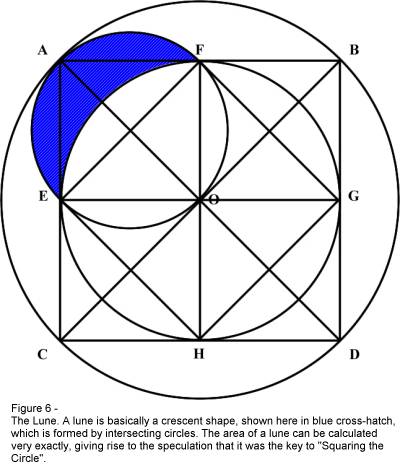
Note
that in Figure 6, the Square ABDC is four times larger than is Square AFOE. The
difference in the relative areas of the two squares and also of the two circles
forming the lune are therefore, proportionate.
In
her book The Music of Pythagoras[xiii],
author Kitty Ferguson describes a scene from Plato’s Meno in which
Socrates and Meno are discussing the figure of a four foot square which Socrates
has drawn in the sand. It is related that during the discussion Socrates uses
this square as a basis for the construction of a figure identical to that shown
in Figure 5, less the circles. In the course of developing this figure, Socrates
leads one of Meno’s servants in a dialog in which the servant deduces that the
area of the larger square is twice that of the smaller square. The entire
purpose of this scene in Meno is to illustrate that man is capable of
developing knowledge by deduction, and does not rely simply upon a priori knowledge,
or knowledge which is already fully developed and present at birth. No doubt,
the figures later published by Agrippa included the symbolism of the ability of
man to discern and to employ deductive reasoning.
However it is the Geometric not the Philosophical principles which are of
interest in paper; it is notable in this respect that the two figures of
interest illustrate proportional characteristics of the human form which are not
directly related to the Golden Mean (Phi or the Divine Ratio). This is not the
case with Leonardo’s Vitruvian Man nor is it the case with the remaining
figures given by Agrippa (as shown in Figure 2).
This
is not to say that the value of Phi cannot be developed using these two figures,
which it clearly can (Figure 7). However the value of Phi does not coincide with
distinct body features in these figures. The fact that these figures are
included with a series of other sketches which clearly describe the Phi
proportions of the human body would lead us to believe that Agrippa considered
the geometric relationships between inscribed and circumscribed squares and
circles to be sufficiently non-coincidental as to be considered evidence of the
divine origin of Man.
This
is of special interest to Freemasonry, since the two figures being discussed
reveal absolute geometric proportions in the human form, and do not depend upon
mathematical (i.e. non-geometric) principles to make this point.7
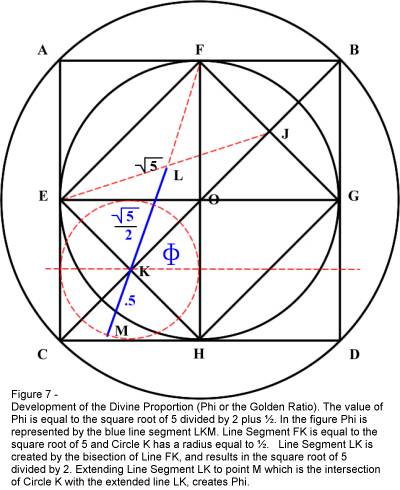
In
Figure 7, consider the rectangle EFJK. If we assume that the long sides of this
rectangle have a dimensional value of two (2) units, and that the short sides a
dimensional value of one (1) unit, then the diagonal of this rectangle (line FK)
has a value equal to the square root of five. The value of Phi is very closely
associated with the square root of five, being equal to the square root of five
divided by two, plus one-half (1.114213 + .5 = 1.614213). By constructing the opposing diagonal JE, we are able to produce Point L
which lies at the bisection of the two diagonals. Therefore in order to
demonstrate the value of Phi in our figure, we have only to add the value of
one-half unit to Line Segment LK. We accomplish this by extending line LK to
Point M, which is the point at which it intersects with Circle K, which has a
radius of ½. The entire line segment LKM then, has a length equal to the square
root of two plus one-half, which is the value of Phi. Note that this process
also results in the construction of Circle K, which is a circle inscribed within
Square EOHC. The ratio of the area of Square EFGH to that of Square EOHC is 4:1;
and consequently the ratio of the area of inner Circle O to that of Circle K is
also 4:1. Further note that Phi may also be developed using Figure 6 as the
basis, in which case the smaller circle is circumscribed about Square AFOE, and
the ratio of Square AFOE and the smaller circle in Figure 6 to Square ABDC and the
outer Circle O, which is circumscribed about Square ABDC is 4:1.
Heraclitus
(540-480) is credited with saying “Man is the measure of all things”[xiv].
This Figure is, as are the two figures in Agrippa’s Occult Philosophy, the
geometric representation of Man as a Divine creation, centered in the universe,
with God-given faculties of reason, and physically formed in Divine proportion.
[i]
Agrippa, Heinrich Cornelius. (1995).
Three Books of Occult
Philosophy. In Donald Tyson
(Ed.). The Foundation Book of Western Occultism. Llewellyn.
ASIN: B000KT6YLK.
[ii]
Agrippa of Nettesheim, Heinrich Cornelius. (1651).
Three Books of Occult Philosophy.
Book 2. London. In Joseph H. Peterson (Ed.). [Digital Edition] . Retrieved
June 18, 2008, from http://www.esotericarchives.com/agrippa/agrippa2.htm.
[iii]
Vitruvius, Pollio. De Architectura
(The Ten Books on Architecture). In Project Gutenberg (2006). Retrieved
June 18, 2008, from http://www.gutenberg.org/etext/20239.
[iv]
Image Source: The Ohio State University Fine Arts Library. Retrieved
June 18, 2008, from http://library.osu.edu/blogs/finearts/2008/02/14/be-mine-frank-ohara/.
[v]
Hatzigeorgiou, Karen J. (2008). Public Domain Images
Reproduced by Agreement of Terms of Publication. Retrieved
June 18, 2008, from http://karenswhimsy.com/sacred-geometry.shtm.
[vi]
Agrippa von Nettesheim, Cornelius. (1651) De Occulta Philosophia Libri Tres.
Edited by V. Perrone Compagne. in Studies in the History of Christian
Thought, 48. Leiden: Brill. (1992).
[vii]
Archimedes. in Bogomolny, Alexander, Archimedes' Book of Lemmas from
Interactive Mathematics Miscellany and Puzzles. Retrieved June 23, 2008
from
http://www.cut-the-knot.org/Curriculum/Geometry/BookOfLemmas/index.shtml.
[viii]
Carothers Neal. Archimedes’ Method of Exhaustion. Department of Methematics
and Statistics. Bowling Green State University. Retrieved June 22, 2008 from
http://personal.bgsu.edu/~carother/pi/Pi3a.html.
[ix]
Euclid’s Elements, Book XII. In Joyce, D.E. (1997) Euclid’s Elements.
Clark University. Retrieved June 22, 2008 from http://aleph0.cl arku.edu/~djoyce/java/elements/bookXII/propXII2.html.
[x]
Sandifer, Charles Edward. (2007). The Early Mathematics of Leonhard Euler.
The Mathematical Association of America - Tercentenary Euler Celebration. Vol.
1.Washington, D.C. ISBN:0883855593
[xi]
Weinstein, Eric. (2008). Lune. Wolframs Math World. Wolfram Research.
Retrieved June 22, 2008. from http://mathworld.wolfram.com/Lune.html
[xii]
Euler, M.J.A. Réflexions Sur la Variation de la
Lune. Publication l'Académie 1766, 18 pp.
[xiii]
Ferguson, Kitty. The Music of Pythagoras. (2008). New York. Walker
& Company. Macmillan (Dist.) ISBN-10:
0-8027-163-8; ISBN-13: 978-0-8027-1631-6. pp. 140-145.
[xiv]
Hemenway, Priya & Ray, Amy. (2005). Divine Proportion: Phi in Art,
Nature, and Science. Sterling. ISBN:1402735227. pp. 92.
|
![]() News Feed |
News Feed |  Subscribe News by Email
Subscribe News by Email